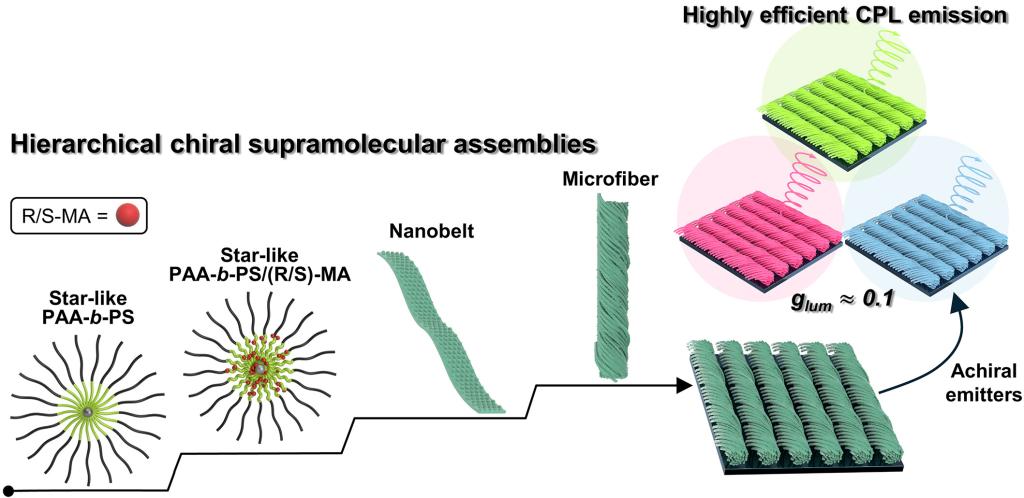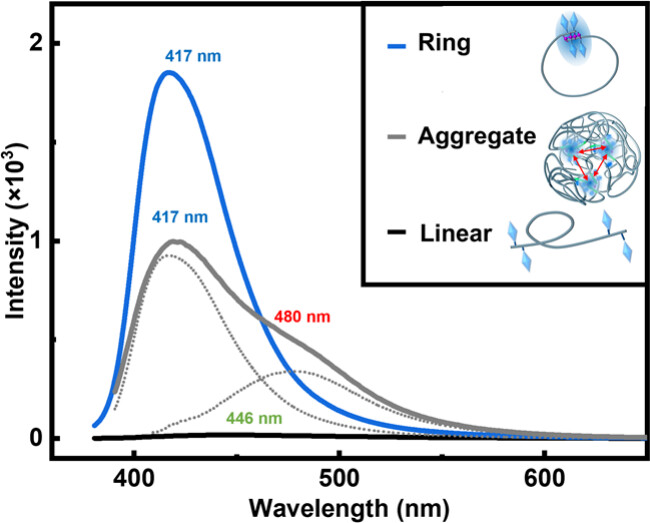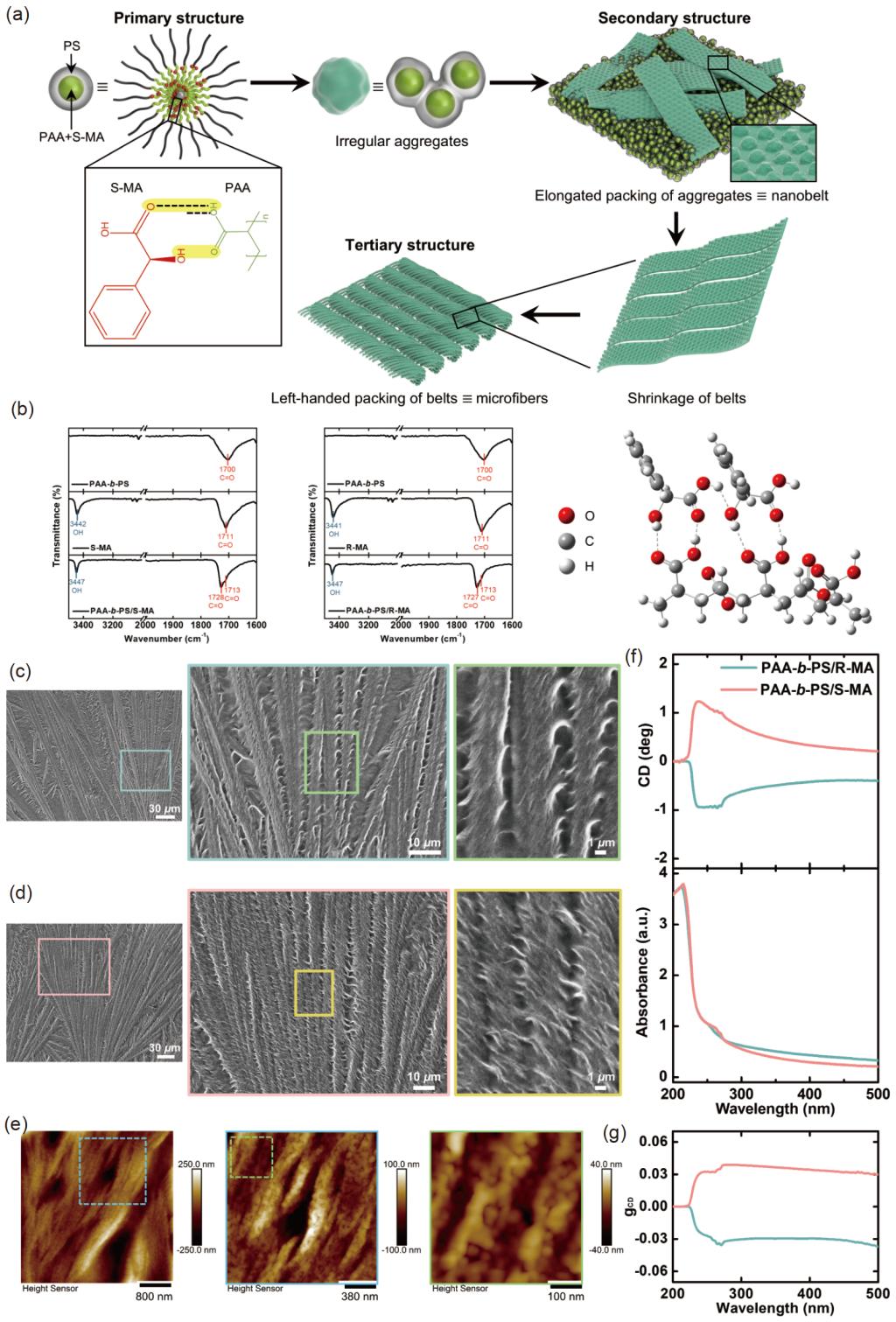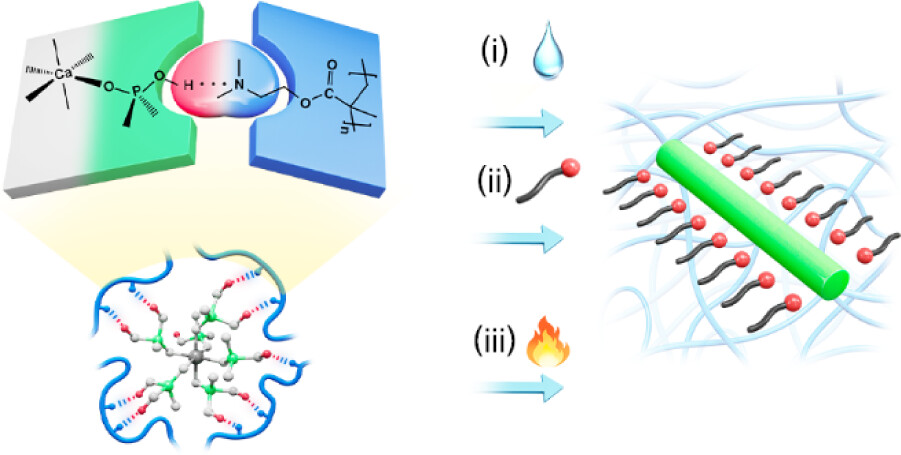Research Articles
1. Zheng, Di; Tao, Jing; Jiang, Liping; Zhang, Xinyue; He, Huibin; Shen, Xiaoxue; Sang,Yutao; Liu, Yunen*; Yang, Zhenzhong*; Nie, Zhihong*. Efficient Cytosolic Delivery of Single-Chain Polymeric Artificial Enzymes for Intracellular Catalysis and Chemo-Dynamic Therapy. J. Am. Chem. Soc., 2025, 147, 998-1007.
Designing artificial enzymes for in vivo catalysis presents a great challenge due to biomacromolecule contamination, poor biodistribution, and insufficient substrate interaction. Herein, we developed single-chain polymeric nanoparticles with Cu/N-heterocyclic carbene active sites (SCNP-Cu) to function as peroxidase mimics for in vivo catalysis and chemo-dynamic therapy (CDT). Compared with the enzyme mimics based on unfolded linear polymer scaffold and multichain cross-linked scaffold, SCNP-Cu exhibits improved tumor accumulation and CDT efficiency both in vitro and in vivo. Protein-like size of the SCNP scaffold promotes passive diffusion, whereas positive surface charge allows its active transcytosis for deep tumor penetration and hence accumulation in the tumor site. The submolecular compartments of the SCNP scaffold effectively protect the active sites from protein bindings, thereby providing a “cleaner” microenvironment for catalysis within a living system. The folded structure of SCNP-Cu facilitates their cytosolic delivery of and free diffusion within cytosol, ensuring efficient contact with endogenous H2O2, in situ generation of toxic hydroxyl radicals (·OH), and effective damage of intracellular targets (i.e., lipids, nucleic acids). This work establishes versatile SCNP-based nanoplatforms for developing artificial enzymes for in vivo catalysis.

https://doi.org/10.1021/jacs.4c14264
2. Yang, Yajing†; Yang, Jiye†; Li, Fenglin; Sun, Dayin; Zhu, Jintao; Nie, Zhihong; Yang, Zhenzhong*. Stepwise Grafting of Polymer Single Chains onto Nanoparticles. Macromolecules, 2025, 58, 1256-1264.
It is important to design hierarchically structured functional polymer/inorganic composite nanoparticles (NPs) and self-organize them toward programmable superstructures thereby. We propose the synthetic approach of stepwise grafting anionic polymer single chains onto functional nanoparticles via termination, which is ensured by the strong steric hindrance effect of the grafted chains to the target chains with a comparable size. The concept is demonstrated by the precision synthesis of NP-inserted diblock copolymer analogies of PVSt-b-PmSt-[Fe3O4@SiO2]-PMMA-b-PtBA with two different polymer single chains at the opposite sides (PVSt-b-PmSt: poly(4-vinylphenyl-1-butene)-block-poly(4-methylstyrene), PMMA-b-PtBA: poly(methylmethacrylate)-block-poly(tert-butyl acrylate)). Both end segments of PVSt and PtBA are reactive to derive functional groups such as amino and carboxylic acids by the orthogonal clicking reaction and hydrolysis. The functional groups allow visualization of the composite NPs by stimulated emission depletion (STED) microscopy upon selective fluorescence dyeing and the self-organization by specific interactions toward superstructures at varied pHs. The approach is valid for the stepwise grafting of six single chains of varied compositions along the three-dimensional coordinate. The composite NPs with defined numbers and types of functional groups, and thus interaction directions, provide a huge platform for diversifying superstructures, especially under external fields.

https://doi.org/10.1021/acs.macromol.4c03032
3. Li, Fenglin; Yang, Yajing; Sun, Dayin; Ye, Yilan; Yang, Zhenzhong*. Scalable synthesis of Janus single-chain/nanoparticle hybrids. Acta Polymerica Sinica, 2025, 56(1), 114-123.
Asymmetric polymer single-chain@nanoparticle hybrids demonstrate fine microstructures and synergetic performances, which serve as important building blocks toward functional materials. It is crucial to develop methodologies for the large-scale preparation of hierarchically structured functional hybrids. Starting from the triblock bottlebrush polymers, Janus nanoparticles composed of Fe3O4 are synthesized on a large scale through electrostatic-mediated intramolecular crosslinking, involving coordination with metallic ions at the central region, which is rich in PVP side chains at a high concentration of 150 mg/mL. Shape of the nanoparticles is controllable from spherical to ellipsoidal by alteration of the length ratio of the backbone and the grafting side chain. PVSt and PBBzSt blocks at the opposite ends of the nanoparticle could be modified orthogonally to derive amino- or (and) carboxylic acid groups. AB type Janus nanoparticles are thus derived, which are able to self- assembly into diverge superstructures upon alteration of pH values. The self-assembly and the superstructures could be easily visualized under stimulated emission depletion microscope (STED) upon fluorescent dyeing the functional groups. A layer of SiO2 is formed at the Fe3O4 NP by the sol-gel process, and bromopropyl- groups are further introduced by using the silane. At the Janus composite nanoparticle, single-chains could be sequentially grafted by steric hindrance assisted termination of living anionic polymer single-chains with tunable composition and microstructure. The Janus composite nanoparticles bearing four different polymer chains display multivalent directional interactions, which are promising to self-assembly functional superstructures.

https://doi.org/10.11777/j.issn1000-3304.2024.24173
4. Li, Penghui; Hu, Yuandu*; Yang, Zhenzhong*. Anisotropic Photonic Microobjects with Dual Stopbands Formed from Single Photonic Dispersion and Their Application for Anticounterfeiting. ACS Appl. Mater. Interfaces, 2025, 17, 15969-15977.
Janus photonic microobjects have shown great potential in various fields due to their anisotropic shapes and tunable optical properties. Microfluidics is useful for constructing such photonic microobjects. The traditional method of injecting different colloidal photonic streams toward anisotropic multiple stopband photonic microobjects involves complicated and time-consuming procedures. Herein, an easy yet effective approach to fabricate Janus photonic microobjects with dual stopbands from a single stream of photonic components is proposed. A microfluidic device is used to prepare bullet-like, single-stopband photonic microobjects by virtue of the microchannel’s confinement effect. Both the size and shape are readily regulated by adjusting the flow rate of the continuous phase. Under the protection of the desired region of the photonic microobjects with polystyrene (PS) film or silicone tube, the other region is selectively etched to generate a new photonic part. The Janus photonic microobjects with dual stopbands are achieved thereby. Precision control of the protection position of the single-stopband photonic microobjects provides the flexibility to achieve photonic microobjects with various segmental combinations. The porous structure at the etched region is conducive to further functionalization, for example, fluorescence performance, by filling polymers. The resultant photonic microobjects with strong information-encoding characteristics are promising in display and anticounterfeiting.

https://doi.org/10.1021/acsami.4c20550
5. Tan, Xuemei; Song, Yuhang; Wan Chuchu; Huang, Caili*; Chai, Yu*; Yang, Zhenzhong*. Magnetic Janus Particles: Synthesis and Multifunctional Applications. Macromol. Rapid Commun. 2025, 46, 2400866.
Magnetic Janus particles (MJPs) with compositional compartmentalization and strong magnetic responsiveness play a pivotal role in various application fields, such as biotechnology, medicine, and materials science. However, comprehensive reviews of the field of MJPs remain limited. Here, this article attempts to fill the gap by reviewing the current common synthetic strategies for MJPs, including masking, microfluidics, self-assembly, phase separation, and seeded emulsion polymerization, among others. It then covers the multifunctional applications of MJPs, beneficial from their magnetic properties and anisotropic topological structure, primarily involving environmental remediation, biomedicine, smart displays, interfacial catalysis, emulsion stabilization, and structured liquid materials are presented, as well. Finally, the current challenges and future perspectives for MJPs are also discussed, aiming to fully harness the potential for broader applications.

https://doi.org/10.1002/marc.202400866
6. Li, Fenglin†; Wen, Zhendong†; Yang, Yajing; Sun, Dayin; Zhu, Jintao; Nie, Zhihong; Yang, Zhenzhong*. Large-Scale Synthesis of Janus Nanorods by Electrostatics-Mediated Intramolecular Cross-Linking of Polymeric Bottlebrushes, J. Am. Chem. Soc., 2025, 147, 6857-6865.
Nanorods are promising to construct functional superstructures. The currently used nanorods are essentially symmetric, with the same materials at the ends. Theoretical prediction indicates that asymmetric Janus nanorods with varied materials at the ends are advantageous in the synthesis of diversified functional self-assembled materials. Herein, we propose a novel method of electrostatics-mediated intramolecular cross-linking of Janus polymer bottlebrushes to synthesize large-scale asymmetric Janus nanorods at an unprecedentedly high concentration of 300 mg/mL. Compositions of both the nanorod body and ends are broadly tunable in an orthogonal mode to endow the nanorod functional groups for self-assembly, which could be visualized under a STED microscope upon dyeing. The sample amino acid analogous Janus nanorods are achieved by the orthogonal hydrolysis and click reaction at the opposite ends, serving as building blocks to self-organize into superstructures from linear wires, branches, and networks that are highly dependent on the valence states.

https://doi.org/10.1021/jacs.4c16990
7. Huo, Lujie; Qu, Kairu; Yang, Zhenzhong; Jia, Di*. Dynamics of Charged Ring Polymers under Gel Confinement. Chinese J. Polym. Sci., 2025, 43, 399-405.
Ring polymers are ubiquitous in various fields including biomaterials, drug release and gene therapy. All of these applications involve the dynamics and diffusion process of ring polymers in a confined environment. By using dynamic light scattering (DLS), we discovered a dynamical transition for charged ring polymers with increasing ring concentration in the gel matrix from a diffusive state to a non-diffusive topological frustrated state with a more compact conformation. When the ring polymer size is smaller than the mesh size of the gel matrix, the rings are diffusive at low concentration of 5 g/L. The ring diffusion coefficient in the gel matrix is an order of magnitude smaller than that of rings in solution, obeying the Ogston’s model. At high ring concentration of 40 g/L, the collective dynamical behavior of the charged rings exhibits a topologically frustrated non-diffusive state, which may originate from the inter-ring threading with the external confinement from the gel matrix. Based on our previous theoretical work, we also conjectured that in such a non-diffusive state, the ring polymers might adopt a more compact conformation with the overall size exponent v=1/3.
https://doi.org/10.1007/s10118-025-3291-0
8. Qu, Kairu; Du, Linhan; Zhou, Shuqi; Huo, Lujie; Gu, Anqi; Lu, Diannan; Chen, Chunlai; Jia, Di; Yang, Zhenzhong*. Large-Scale Synthesis of Polymer Rings by Electrostatic-Mediated Closure of Single-Chain Nanoparticles. Macromolecules, 2025, 58, 4131-4137.
Polymer rings are unique over their linear counterparts in fundamental and engineering aspects. Although ring closure of polymers is a proven general method toward rings, the large-scale synthesis in concentrated solutions remains challenging due to the concurrent intermolecular reactions. Herein, we propose the electrostatic-mediated ring closure of polymers in the dynamic single-chain nanoparticle (SCNP) globular state, enabling large-scale synthesis of highly pure polymer rings at an unprecedentedly high concentration of 150 mg/mL. The dynamic SCNPs are also achieved by the electrostatic-mediated intramolecular cross-linking of polymers in concentrated solutions. Poly(2-(dimethylamino)ethyl methacrylate) (PDMAEMA)-based telechelic polymers are selected to demonstrate the concept. The charged dynamic SCNPs are constructed by simple amine-acid-specific interactions, and thiol–ene and Diels–Alder click reactions are employed for the ring closure to demonstrate the generality. The microstructure and composition of the rings can be tuned from the corresponding polymers with varied segmental sequences and compositions. The topology and function can be further tuned by the favorable growth of functional materials at the desired sites of the polymer rings.

https://doi.org/10.1021/acs.macromol.5c00409
9. Du, Xiaoyang; Zhang, Shuchen; Zhou, Junqi; Chi, Hongxiang; Sheng, Zhejia; Hu, Yuandu*; Shang, Chao; Wang, Tao*; Chen, Guang; Yang, Zhenzhong*. Inverse Opal Torus-Shaped Photonic Microobjects with Superior Stimulus-Responsive Properties to Their Spherical Equivalents. Small, 2025, 21, 2412117.
Because of their many uses and simplicity of manufacture, colloidal photonic microobjects made from droplet templates have been the subject of extensive research. Owing to the low interfacial energy, the majority are spherical, however nonspherical forms, such as torus-shaped photonic microobjects (TSPMs) have also been seen. Although there have been reports of TSPMs based on various colloidal building blocks, their usual lack of stimulus-responsive qualities restricts their potential uses. In this work, hydrogel-based inverse opal TSPMs (IO-TSPMs) that are sensitive to alcohol and pH are created. IO-TSPMs that react more quickly than spherical ones are produced by first creating opal-structured TSPMs, then infiltrating monomers, polymerizing under UV light, and etching, to visibly illustrate the difference. Unlike spherical structures, which only provide unidirectional stimulus propagation, torus structures allow stimulation to bidirectionally propagate from both the inner and outer borders. Potential applications for these IO-TSPMs include biomimetic materials, quick diagnostic and inspection tools, and building blocks for innovative patterns.

https://doi.org/10.1002/smll.202412117
10. Yang, Jiye; Sun, Dayin; Gu, Anqi; Wen, Zhendong; Wang, yan; Yang, Zhenzhong*. Scavenger Resin Enabling Simplification of Complicated Living Anionic Polymerization. ACS Appl. Polym. Mater., 2025, 7, 6493-6499.
Since Szwarc first proposed living anionic polymerization in Nature (1956), this method has proven to be the most powerful approach for large-scale synthesis of nearly uniform polymers with tunable compositions and microstructures. Eliminating various impurities toward the absolute purification of reagents and vessels is a prerequisite for living polymerization. Conventional purification methods are laborious and highly specific for the reagents, significantly limiting the potential of the anionic polymerization. Herein, we develop a facile and universal purification method by the anionic initiating scavenger resin that eliminates impurities via self-sacrificial reactions, substantially simplifying the process. For representative synthesized homopolymers, the degree of polymerization (DP) shows a strict linear correlation with monomer/initiator molar ratios (R) according to DP = R while maintaining low dispersity indices (Đ ≈ 1.03). The living anionic polymerization also enables scalable production of nearly uniform copolymers through designed one-batch sequential polymerization. This large-scale synthesis of composition-controlled polymers with a narrow distribution advances the fundamental understanding of structure-performance relationships and supports the precise construction of uniform self-assembled nanostructures.

https://doi.org/10.1021/acsapm.5c00954
11. Qu, Kairu; Yang, Zhenzhong*. Synthesis of Compact Single-Chain Nanoparticles in Concentrated Solutions. Macromolecules, 2025, 58, 6837-6843.
Although a large family of covalently cross-linked robust single-chain nanoparticles (SCNPs) have been extensively synthesized, they are sparsely cross-linked, lacking precision control of the compactness. Herein, we propose a facile method to achieve robust SCNPs with tunable compactness by covalent cross-linking of the parent dynamic SCNPs. As proof of the concept, the dynamic SCNPs are large-scale synthesized at 200 mg/mL by the electrostatics-mediated intramolecular physical cross-linking of poly(N,N-dimethylaminoethyl methacrylate) (PDMAEMA)-based polymers via amino/acid-specific interactions. The compactness of the dynamic SCNPs is greatly tunable from sparsely cross-linked to the globular state with scaling parameters from 0.57 to 0.34 by altering the cross-linking degree and spacer length of the cross-linker. The robust SCNPs with tunable compactness are derived by subsequent covalent cross-linking of the dynamic SCNPs. The SCNPs are featured with functional microdomains distinctly compartmentalized by using functional agents and preferential growth of functional materials thereby.

https://doi.org/10.1021/acs.macromol.5c00611
12. Guo, Lvzhou; Wu, Chaohao; Holger, Merlitz; Chen, Jiajia; Yang, Zhenzhong; M. Gregory, Forest; Wu, Chenxu; Cao, Xuezheng*. Design of High-Performance Viscoelastic Polymer Nanocomposites Using Stiff Nanorings. Macromolecules, 2025, 58, 6149-6157.
The pursuit of polymer nanocomposites (PNCs) that simultaneously exhibit high strength and toughness has long been hindered by the intrinsic trade-offs between these properties. Here, we introduce a groundbreaking strategy by integrating stiff nanorings (SNRs) into polymer melts, enabling unprecedented mechanical performance without relying on traditional cross-linking or filler reinforcement. Through advanced statistical rheological simulations, we reveal that threading polymer chains through SNRs transforms the melt into a gel-like hyperviscous fluid, despite the absence of permanent or transient cross-links. Under applied strain, the dynamic sliding of polymer chains along the constrained SNRs concentrates stress on the nanorings, effectively delaying chain relaxation and minimizing chain breakage. This innovative mechanism not only enhances both strength and toughness but also imparts exceptional viscoelastic properties, surpassing those of conventional polymer melts. Our findings establish SNRs as dynamic stress-dissipative units, offering a versatile and scalable platform for designing next-generation PNCs. This work opens new avenues for applications in extreme mechanical environments, from advanced manufacturing to biomedical engineering, and represents a paradigm shift in PNC science.

https://doi.org/10.1021/acs.macromol.5c01029
13. Ren, Yingying; Wu, Wenze; Lu, Yuxuan; Liu, Yang; Jin, Haiqiang*; Li, Xiaoyi; Qu, Xiaozhong*; Yang, Zhenzhong*. Fluorescence Visualization of Strain by Tetraphenylethylene/Ruthenium Complex Three-Dimensional Covalent Organic Framework Assemblies. J. Am. Chem. Soc., 2025, 147, 20033-20044.
Dynamic visualization of strain and its distribution in materials are still challenging. Herein, dual-fluorophore three-dimensional covalent organic frameworks (3D-COFs) and the PEGylated 3D-COFs (PEG-3D-COFs) were synthesized for the construction of physically interacted assemblies to realize fluorescence imaging on not only strain distribution but also strain-related surface friction and flow velocity distributions in various media including polymer elastomers, organic or aqueous dispersions. The responsiveness arises from the controllability of the aggregation structure of 3D-COFs and PEG-3D-COFs, showing concentration-dependent morphology and photoluminescence, and meanwhile having a concentration-deformation equivalence on the structural evolution dynamics which drives the color change of the COF emission in the solids and liquids with high sensitivity and reversibility, whenever the superstructure of the COF assemblies is affected by the applied strain on the matrices. The report will inspire further efforts to construct responsive COFs for optical measurement aims.

https://doi.org/10.1021/jacs.5c05354
14. Yang, Yongjia; Wang, Hesong; Hong, Song; Zhu, Haimei; Jiang, Xiaojun; Ge, Linxin; Cui, Yu-ang; Yuan, Kai*; Yang, Zhenzhong*; Jiang, Bingyin*. Polypeptide Single-Chain Nanoparticle Derived Artificial Enzyme. Adv. Healthcare Mater., 2025, e02053.
Polyamino acids synthesized via ring-opening polymerization (ROP) of N-carboxyanhydride (NCA) monomers offer a scalable route to functional polypeptides, but the lack of sequence specificity limits their ability to fold and function like natural enzymes. Here, a series of artificial enzymes is developed based on single-chain nanoparticles (SCNPs) formed through intramolecular folding of a triblock copolypeptide, polyethylene glycol-b-poly(L-glutamic acid)-b-poly(oligo(ethylene glycol)-L-glutamate) (PEG113-b-PGlu112-b-P(Glu-EG2)99). The central poly-Glu block is intramolecularly cross-linked via coordination with transition metal ions (Fe2+/Fe3+, Mn2+, Co2+, Cu2+/Zn2+), mimicking the natural folding of polypeptides into proteins. Co-precipitation with ammonia water generates metal/alloy oxide nanoclusters within the cross-linked polyGlu domain, providing a large surface-to-volume ratio. The metal oxide nanoclusters function as coenzymes. They not only facilitate a structural transition from α-helices to β-strands within the cross-linked polyGlu domain but also demonstrate specific peroxidase (POD) or superoxide dismutase (SOD) activities, which are tailored to the specific metal species involved. The FeOx-complexed artificial enzyme (Fe-enzyme) is selected to exemplify its therapeutic effects of mitigating oxidative stress and inflammation in a rheumatoid arthritis mouse model. These artificial enzymes feature a soft, degradable polypeptide skeleton, tunable side-chain functionalities, high enzyme-like activity with minimal metal content (< 5 wt.%), and secondary structures similar to natural proteins.

https://doi.org/10.1002/adhm.202502053
15. Zhang, Lei†; Zhang, Xuze†; Shi, Rui; Wu, Shilong; Xu, Chaohao; You, Jichun; Zhang, Yu; Li, Mingyang; Xu, Wenyu; Li, Qinglin; Yang, Zhenzhong*; Lu, Zhongyuan*; Qian, Hujun*. Single-chain nanoparticles break the strength-toughness-processability trilemma in polymer glasses. Phys. Rev. Lett., 2025, 135, 118101.
The strength-toughness trade-off in polymer glasses presents a fundamental challenge, as enhancing one property typically compromises the other. Moreover, efforts to enhance mechanical performance often lead to increased melt viscosity, which in turn hinders processability. Here, we demonstrate that incorporating single-chain nanoparticles (SCNPs) breaks this trilemma by simultaneously enhancing strength, toughness, and processability. Through a combined experimental and molecular dynamics (MD) simulation approach, we reveal that SCNPs with higher glass transition temperature than the matrix not only increase yield strength but also delay and homogenize crazing, leading to dramatically improved toughness in the glassy state. Importantly, the SCNPs reduce melt viscosity in the molten state, countering the conventional trend of viscosity increase in nanocomposites. This triple enhancement establishes a universal framework for designing high-performance polymer glasses that transcend traditional material property limitations.

https://doi.org/10.1103/nm5z-2hxm
16. Kim, Minju†; Zhang, Mingyue†; Zhu, Youliang; Yan, Yan; Pu, Xin; Choi, Woosung; Chung, Sein; Cho, Kilwon; Kim, Jeongwon; Vladimir, Tsukruk; Yang, Zhenzhong*; Nicholas, A. Kotov*; Lu, Zhongyuan*; Kim, Dongha*; Lin, Zhiqun*. Hierarchical Chiral Supramolecular Assemblies with Invertible Chiroptical Characteristics. Science, 2025, 389(6761), eadu0296.
Supramolecular assemblies hold great promise for advanced chiral materials because of their structural diversity and dynamic features, but their low chiroptical activity limits practical applications.We report hierarchical supramolecular assemblies with giant chiroptical activity and mechanical attributes achieved through coassembly of achiral amphiphilic unimolecular micelles and chiral additives. Chiral fibrillar assemblies emerge from the nanostructured environment imposed by the micelles, driven by progressive chirality transfer through multiple hydrogen bonds between components. Integrating multifarious achiral luminescent molecules and nanocrystals into these assemblies leads to full-color circularly polarized luminescence–active materials with dissymmetry factors of ~10−1. A concentration-dependent chirality inversion is accessed through tailoring the coassembly kinetics. This strategy enables efficient red CPL, crucial for quantum and optical technologies.

https://doi.org/10.1126/science.adu0296
17. Qu, Kairu; Xiong, Zuping; Gu, Anqi;Yang, Shancheng; Hu, Binjie; Zhang, Haoke; Yang, Zhenzhong*; AIEgen Functionalized Polymer Ring. Macromolecules, 2025, 58, 12064-12071.
Intramolecular closure is an effective method to derive polymer rings in which the ends of the parent polymer chains are strongly connected. It is important to develop simple and sensitive methods to discriminate between the intramolecular ring closure and intermolecular cross-linking. Herein, we propose the aggregation-induced emission (AIE) based method to monitor the intramolecular closure of polymer chains. The example polymer of poly(pentafluorophenyl methacrylate)-block-poly(2-(dimethylamino) ethyl methacrylate)-block-poly(pentafluorophenyl methacrylate) (PPFPMA-b-PDMAEMA-b-PPFPMA) is synthesized by RAFT polymerization, and the AIEgens and reactive styryl groups are grafted at the end blocks by reactions with 1-(4-aminophenyl)-1,2,2-triphenylethene and 4-vinylaniline. Along with the electrostatics-mediated intramolecular closure at the dynamic single-chain nanoparticle (SCNP) via ultraviolet (UV)-irradiated radical reaction toward the polymer rings, the AIEgens become highly restricted at the individual cross-linked cluster, giving a rather bright, spectrally narrow emission at 417 nm. In contrast, multiclusters are present at the intermolecularly cross-linked aggregate which are strongly coupled giving an additional red-shifted emission at 480 nm. The resulting AIEgen-functionalized polymer rings therefore combine sharply defined fluorescence signatures with enhanced stability in poor solvents, offering promise as functional optical materials and potential diagnostic probes.

https://doi.org/10.1021/acs.macromol.5c02698
18. Zhang Mingyue, Kim Minju, Yang zhenzhong*, Lu Zhongyuan*, Lin Zhiqun*. Hierarchical chiral supramolecular assemblies: a new strategy towards strong and invertible circularly polarized light emission (in Chinese). Chin Sci Bull, 2025, doi: 10.1360/CSB-2025-5467

https://doi.org/10.1360/CSB-2025-5467
19. Wu Angxuan, Sun Rui, Qian Xiaolin, Guo Baosheng, Li Zhiwei, Li Daqi, Yu Wenwen, Ye Yilan*, Yang Zhenzhong*. Hydrogen Bonding-Assisted Sequential Mineralization of Polymer-Stabilized Ionic Clusters. Macromolecules, 2025, 58, 13352-13362.
Biomineralization achieves intricate hybrid nanostructures through the biomolecule-directed organization of ionic clusters. However, the regulation of ionic clusters remains challenging for biomimetic mineralization. Herein, we establish hydrogen bonding–stabilized calcium phosphate (CaP) clusters in ethanol using poly(2-(dimethylamino)ethyl methacrylate) (PDMAEMA) as polymeric capping agents. Through tunable hydrogen bonding, we obtain PDMAEMA-regulated CaP clusters of diverse metastable states: (i) concentration-dependent reversible aggregation of CaP clusters, which form hybrid networks; (ii) thermally triggered irreversible aggregation of CaP clusters, which render enhanced networks; (iii) H2O-induced coassembly of CaP clusters and PDMAEMA into hybrid nanochains and phase separation, leading to metastable interfaces. By progressively destabilizing hydrogen bonding through the stepwise addition of H2O, competitive capping agents, and mild heating, sequential mineralization is enabled . Such a sequential pathway drives the controlled transformation of CaP clusters within the PDMAEMA matrix, achieving hydroxyapatite nanorods with tunable aspect ratios under mild conditions, providing new avenues for nanomaterial design.

https://doi.org/10.1021/acs.macromol.5c03164